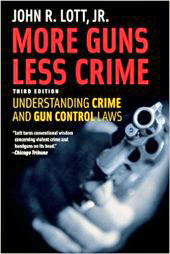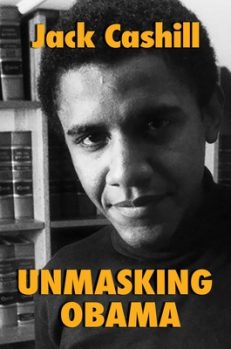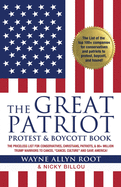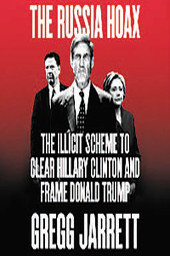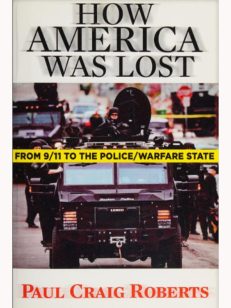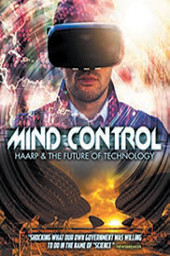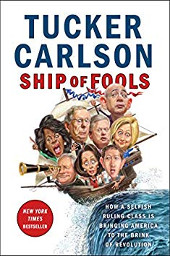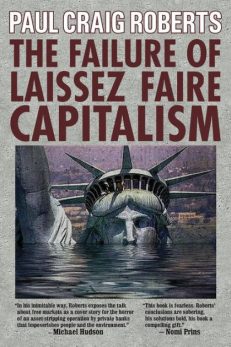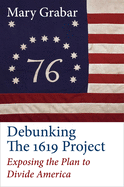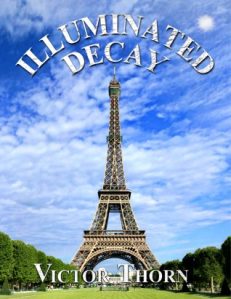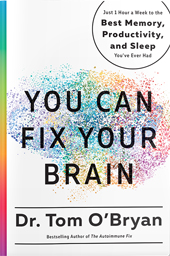Description
On its initial publication in 1998, John R. Lott’s More Guns, Less Crime drew both lavish praise and heated criticism. More than a decade later, it continues to play a key role in ongoing arguments over gun-control laws: Despite all the attacks by gun control advocates, no one has ever been able to refute Lott’s simple, startling conclusion that more guns mean less crime.
Relying on the most rigorously comprehensive data analysis ever conducted on crime statistics and right-to-carry laws, the book directly challenges common perceptions about the relationship of guns, crime, and violence. For this third edition, Lott draws on an additional 10 years of data—including provocative analyses of the effects of gun bans in Chicago and Washington, D.C.—that brings the book fully up to date and further bolsters its central contention.
Contents:
How to Test the Effects of Gun Control; Gun Ownership, Gun Laws, and the Data on Crime; Concealed-Handgun Laws and Crime Rates: Empirical Evidence; Victims and Benefits from Protection; What Determines Arrest Rates and the Passage of Concealed-Handgun Laws?; The Political and Academic Debate by 1998; Final Thoughts; Updating the Results in 2000; A Decade Later: Nine More Years of Data; Nine More State Appendices; Bibliography; Index.
Softcover, 442 pages.
About the Author
Reviews
“This sophisticated analysis yields a well-established conclusion that supports the wisdom of the Second Amendment to the United States Constitution rather than of those who would limit the right of law-abiding citizens to own and carry guns.… Lott has done us all a service by his thorough, thoughtful scholarly approach to a highly controversial issue.”—Milton Friedman
“A compelling book with enough hard evidence that even politicians may have to stop and pay attention. More Guns, Less Crime is an exhaustive analysis of the effect of gun possession on crime rates.… Mr. Lott’s book—and the factual arsenals of other pro-gun advocates—are helping to redefine the argument over guns and gun control.”—James Bovard, Wall Street Journal
“Law and economics professor John R. Lott Jr. presents reams of evidence that violent crime decreases in places where laws are passed permitting concealed weapons. His explanation is that even criminals respond logically to benefits and costs: they don’t like to attack people who might be packing heat.… Lott’s pro-gun argument has to be examined on the merits, and its chief merit is lots of data.… If you still disagree with Lott, at least you will know what will be required to rebut a case that looks pretty near bulletproof.”— Peter Coy, Business Week
Review of More Guns Less Crime, Third Edition, from Timothy H. Lee, published at the Center for Individual Freedom:
John Lott: More Guns, Still Less Crime
“I would ask gun control advocates one question: name a single place in the entire world where murder rates fell after gun control laws were passed.”
That is the powerful challenge from economist Dr. John Lott, Jr., who was kind enough to discuss with CFIF the third edition release of his tectonic book More Guns, Less Crime.
Over a decade has passed since More Guns, Less Crime was released in 1998, immediately remaking the gun rights debate landscape. Lott, who brought an economist’s empiricism to a debate saturated in passion but short on probative data, proposed “a critical review of the existing evidence on gun control and crime.” Accordingly, he asked: “Does allowing people to own or carry guns deter violent crime, or does it simply cause more citizens to harm each other?”
Lott’s objective conclusion was controversial in 1998, less so today.
Based upon broad data sources and examination of FBI annual crime figures for all 3,054 American counties spanning sixteen years, he found that waiting periods, gun buybacks and background checks “yield virtually no benefits in crime reduction.” In contrast, Lott observed that “of all the methods studied so far by economists, the carrying of concealed handguns appears to be the most cost-effective method for reducing crime.”
We’ve now had a decade to digest More Guns, Less Crime.
Twelve years can be long and cruel on watershed books, withering them beneath the harsh glare of events and critical analysis. By way of illustration, recall 1999’s Dow 36,000.
Not so with More Guns, Less Crime. As stated by Dr. Lott and boldly noted in the preface to the new third edition, not a single antagonist has refuted his empirical conclusion that more firearms result in reduced crime.
So what makes a third edition vital? What makes it a critical addition to Americans’ book collections? Plenty.
When More Guns, Less Crime was initially published, only eighteen states possessed right-to-carry firearms laws. Today, that number has more than doubled to thirty-nine states. Obviously, that dramatic increase provides an even larger base of data to test Lott’s research.
Further, the original edition examined sixteen years of data, 1977 through 1992. The third edition now covers twenty-nine years, which is particularly helpful since so many more states have adopted right-to-carry laws during that interim.
Another reason that a third edition is essential is that critics have had twelve years to critique Lott’s proposition. As Lott states, however, “not a single refereed study finds the opposite result, that right-to-carry laws have a bad effect on crime.” Lott’s latest edition also addresses the impact of “Castle Doctrine” laws, which refer to the adage that “a man’s home is his castle” and make it unnecessary for potential crime victims to retreat as far as possible before using a firearm in self-defense.
Also addressed by the new third edition is the federal “assault weapons” legislation, which took effect in 1994 but terminated in 2004. Gun control advocates predicted an explosion in murder and violent crime when the ban expired, but rates actually declined substantively. As Lott notes, “rarely do we get a chance to look at the impact of gun laws when they are first passed and then when they are eliminated.”
In just the past two years, moreover, the United States Supreme Court has for the first time ruled on the long-debated issue of whether the Second Amendment protects an individual, as opposed to collective, right to keep and bear arms. Immediately following the Court’s District of Columbia v. Heller decision, the Washington, D.C. murder rate fell 25% (compared to a 7% nationwide reduction). Lott notes that the city of Chicago shows the opposite pattern, as the murder rate “exploded” after imposing its 1982 gun ban.
In the new third edition, Lott also addresses the inefficacy of such things as waiting periods, mandatory trigger locks and gun show regulations. Each of these regulations raises obstacles for people to defend themselves, thereby making it easier for criminals to prey on weaker citizens with greater confidence.
And, as noted above, Dr. Lott has not encountered a single jurisdiction in the entire world where imposing gun control laws triggered a decline in murder rates.
The bottom line today, just as was true in 1998, is that “the very rules that seek to save lives can result in more deaths.” Dr. Lott has thus provided an invaluable service to America and the world audience generally.
Twelve years of additional experience and mountains of data confirm the empirical truth – more guns in the hands of law-abiding citizens mean less crime.
[Review source: Timothy H. Lee, “John Lott: More Guns, Still Less Crime,” Center for Individual Freedom, (cfif.org)]
An interview with John R. Lott Jr., author of More Guns, Less Crime: Understanding Crime and Gun Control Laws, University of Chicago. (This interview was conducted in 1998, when More Guns, Less Crime was first published.)
Question: What does the title mean: More Guns, Less Crime?
John R. Lott Jr.: States with the largest increases in gun ownership also have the largest drops in violent crimes. Thirty-one states now have such laws—called “shall-issue” laws. These laws allow adults the right to carry concealed handguns if they do not have a criminal record or a history of significant mental illness.
Question: It just seems to defy common sense that crimes likely to involve guns would be reduced by allowing more people to carry guns. How do you explain the results?
Lott: Criminals are deterred by higher penalties. Just as higher arrest and conviction rates deter crime, so does the risk that someone committing a crime will confront someone able to defend him or herself. There is a strong negative relationship between the number of law-abiding citizens with permits and the crime rate—as more people obtain permits there is a greater decline in violent crime rates. For each additional year that a concealed handgun law is in effect the murder rate declines by 3 percent, rape by 2 percent, and robberies by over 2 percent.
Concealed handgun laws reduce violent crime for two reasons. First, they reduce the number of attempted crimes because criminals are uncertain which potential victims can defend themselves. Second, victims who have guns are in a much better position to defend themselves.
Question: What is the basis for these numbers?
Lott: The analysis is based on data for all 3,054 counties in the United States during 18 years from 1977 to 1994.
Question: Your argument about criminals and deterrence doesn’t tell the whole story. Don’t statistics show that most people are killed by someone they know?
Lott: You are referring to the often-cited statistic that 58 percent of murder victims are killed by either relatives or acquaintances. However, what most people don’t understand is that this “acquaintance murder” number also includes gang members killing other gang members, drug buyers killing drug pushers, cabdrivers killed by customers they picked up for the first time, prostitutes and their clients, and so on. “Acquaintance” covers a wide range of relationships. The vast majority of murders are not committed by previously law-abiding citizens. Ninety percent of adult murderers have had criminal records as adults.
Question: But how about children? In March of this year [1998] four children and a teacher were killed by two school boys in Jonesboro, Arkansas. Won’t tragedies like this increase if more people are allowed to carry guns? Shouldn’t this be taken into consideration before making gun ownership laws more lenient?
Lott: The horrific shooting in Arkansas occurred in one of the few places where having guns was already illegal. These laws risk creating situations in which the good guys cannot defend themselves from the bad ones. I have studied multiple victim public shootings in the United States from 1977 to 1995. These were incidents in which at least two or more people were killed and or injured in a public place; in order to focus on the type of shooting seen in Arkansas, shootings that were the byproduct of another crime, such as robbery, were excluded. The effect of “shall-issue” laws on these crimes has been dramatic. When states passed these laws, the number of multiple-victim shootings declined by 84 percent. Deaths from these shootings plummeted on average by 90 percent, and injuries by 82 percent.
For other types of crimes, I find that both children as well as adults are protected when law-abiding adults are allowed to carry concealed handguns.
Finally, after extensively studying the number of accidental shootings, there is no evidence that increasing the number of concealed handguns increases accidental shootings. We know that the type of person who obtains a permit is extremely law-abiding and possibly they are extremely careful in how they take care of their guns. The total number of accidental gun deaths each year is about 1,300 and each year such accidents take the lives of 200 children 14 years of age and under. However, these regrettable numbers of lives lost need to be put into some perspective with the other risks children face. Despite over 200 million guns owned by between 76 to 85 million people, the children killed is much smaller than the number lost through bicycle accidents, drowning, and fires. Children are 14.5 times more likely to die from car accidents than from accidents involving guns.
Question: Wouldn’t allowing concealed weapons increase the incidents of citizens attacking each other in tense situations? For instance, sometimes in traffic jams or accidents people become very hostile—screaming and shoving at one another. If armed, might people shoot each other in the heat of the moment?
Lott: During state legislative hearings on concealed-handgun laws, possibly the most commonly raised concern involved fears that armed citizens would attack each other in the heat of the moment following car accidents. The evidence shows that such fears are unfounded. Despite millions of people licensed to carry concealed handguns and many states having these laws for decades, there has only been one case where a person with a permit used a gun after a traffic accident and even in that one case it was in self-defense.
Question: Violence is often directed at women. Won’t more guns put more women at risk?
Lott: Murder rates decline when either more women or more men carry concealed handguns, but a gun represents a much larger change in a woman’s ability to defend herself than it does for a man. An additional woman carrying a concealed handgun reduces the murder rate for women by about 3 to 4 times more than an additional man carrying a concealed handgun reduces the murder rate for men.
Question: Aren’t you playing into people’s fears and prejudices though? Don’t politicians pass these shall-issue laws to mollify middle-class white suburbanites anxious about the encroachment of urban minority crime?
Lott: I won’t speculate about motives, but the results tell a different story. High crime urban areas and neighborhoods with large minority populations have the greatest reductions in violent crime when citizens are legally allowed to carry concealed handguns.
Question: What about other countries? It’s often argued that Britain, for instance, has a lower violent crime rate than the USA because guns are much harder to obtain and own.
Lott: The data analyzed in this book is from the USA. Many countries, such as Switzerland, New Zealand, Finland, and Israel have high gun-ownership rates and low crime rates, while other countries have low gun ownership rates and either low or high crime rates. It is difficult to obtain comparable data on crime rates both over time and across countries, and to control for all the other differences across the legal systems and cultures across countries. Even the cross country polling data on gun ownership is difficult to assess, because ownership is underreported in countries where gun ownership is illegal and the same polls are never used across countries.
Question: This is certainly controversial and there are certain to be counter-arguments from those who disagree with you. How will you respond to them?
Lott: Some people do use guns in horrible ways, but other people use guns to prevent horrible things from happening to them. The ultimate question that concerns us all is: Will allowing law-abiding citizens to own guns save lives? While there are many anecdotal stories illustrating both good and bad uses of guns, this question can only be answered by looking at data to find out what the net effect is.
All of chapter seven of the book is devoted to answering objections that people have raised to my analysis. There are of course strong feelings on both sides about the issue of gun ownership and gun control laws. The best we can do is to try to discover and understand the facts. If you agree, or especially if you disagree with my conclusions I hope you’ll read the book carefully and develop an informed opinion.


